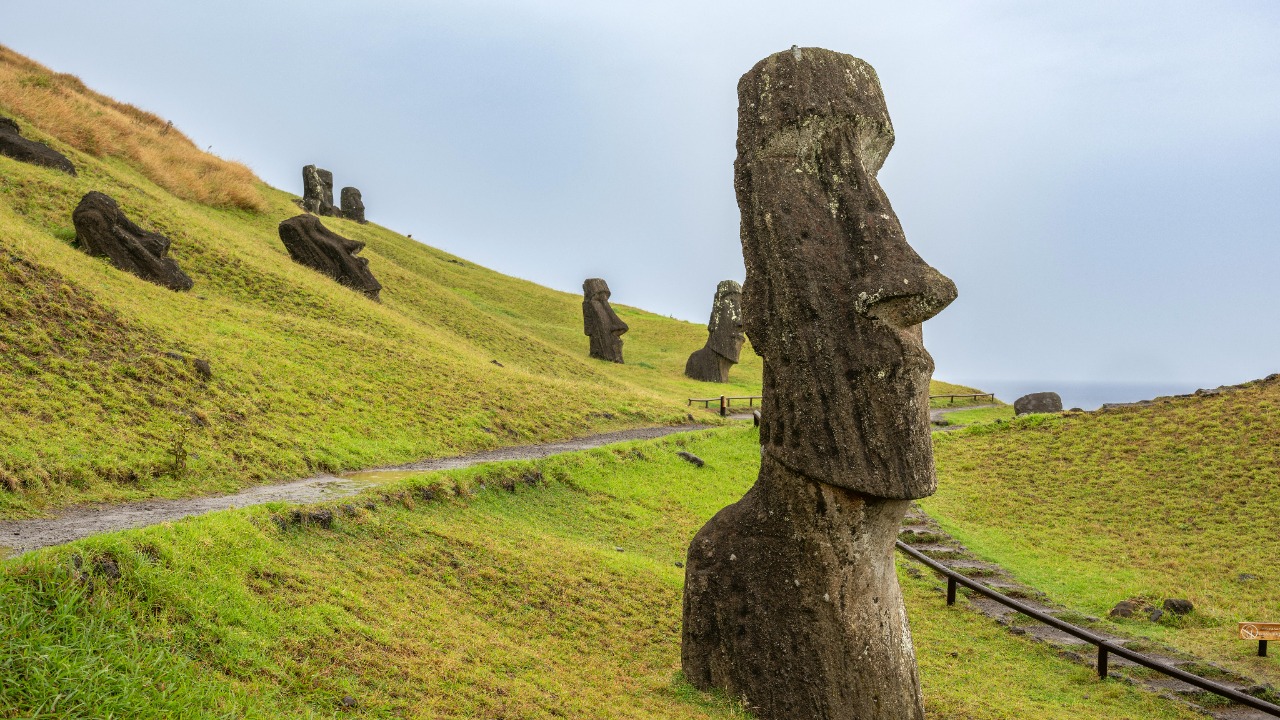
A groundbreaking study published in October 2025 has confirmed that the iconic moai statues of Easter Island were moved into place by “walking” them upright using ropes. This discovery resolves a long-standing archaeological mystery about how these massive stone figures, some weighing up to 82 tons, reached their platforms across the island. The method, first proposed in earlier experiments, was validated through biomechanical analysis showing it required only 15-18 people per statue, providing a practical explanation for the distribution of nearly 1,000 moai across Rapa Nui, or Easter Island.
The Historical Enigma of the Moai Statues
The moai statues of Easter Island, carved from volcanic tuff between 1200 and 1680 CE, have long puzzled archaeologists. Nearly 1,000 statues were produced, many standing up to 10 meters tall and weighing 82 tons. These statues were found erected on stone platforms called ahu around the island’s coast, some as far as 18 kilometers from the quarry at Rano Raraku. Despite their massive size, there is no evidence of large-scale logging for rollers or widespread toppling damage, which has fueled speculation about their transportation methods [source].
Rapa Nui oral histories have long referred to the moai as having “walked” to their locations, a concept that Western archaeologists largely dismissed until recent reevaluations. These traditions describe the statues as moving under their own power, guided by ancestral mana. This cultural perspective offers a unique insight into the ingenuity and beliefs of the Rapa Nui people, challenging previous assumptions about their capabilities and societal organization [source].
Early Theories and Experimental Approaches
Traditional hypotheses about the transportation of the moai included dragging the statues on wooden sledges or using log rollers. These methods were tested in 1986 by Thor Heyerdahl’s expedition but required excessive resources and left unexplained the logistics of moving the statues from the quarry to their platforms. The lack of evidence for large-scale deforestation on the island further complicated these theories, suggesting that alternative methods were used [source].
In 2012, researchers Terry Hunt and Carl Lipo conducted an experiment that successfully “walked” a 5-ton replica moai using ropes and a small team. This experiment mimicked a bipedal rocking motion, allowing the statue to move without tipping over. Their findings aligned with petroglyph evidence showing moai being upright during transport, challenging ideas of prone movement and preserving the statues’ bases from wear [source].
New Scientific Validation of the Walking Method
The October 2025 study, conducted by researchers from the University of Liverpool, used biomechanical modeling to simulate the forces needed to walk moai weighing 10-20 tons. The study confirmed that stability could be achieved with ropes pulled by 15-18 people in a coordinated “hula”-like sway. This method was not only efficient but also required minimal materials, aligning with the resource-scarce environment of the Rapa Nui [source].
Evidence from statue wear patterns, including basal scratches and “stepped” feet, supports the theory that the statues were moved by side-to-side rocking rather than sliding or rolling. This method preserved the integrity of the statues and provided a feasible explanation for their widespread distribution across the island. The study’s findings offer a new perspective on the engineering capabilities of the Rapa Nui people and their ability to adapt to their environment [source].
Cultural and Archaeological Implications
The walking theory not only honors Rapa Nui traditions but also integrates indigenous knowledge with modern science. By acknowledging the role of ancestral mana in the movement of the moai, this research counters narratives of societal collapse due to overexploitation. Instead, it highlights the resilience and ingenuity of the Rapa Nui people, offering a more nuanced understanding of their history and culture [source].
This new understanding has broader implications for Easter Island archaeology, prompting a reevaluation of nearly 400 moai still at the Rano Raraku quarry, some of which are partially buried in walking-ready positions. Future research may focus on applying the walking model to inland moai transport and collaborating with Rapa Nui descendants to restore cultural context to the sites. Such efforts could enhance our appreciation of the island’s heritage and the enduring legacy of its people [source].